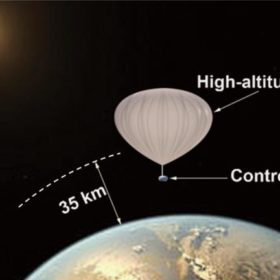UK researchers seek to use perovskite solar cells for hydrogen production
A research team has applied a waterproof coating obtained from graphite to a perovskite cell intended to power the production of hydrogen underwater. The cell is said to have worked underwater longer than expected.
Enhancing perovskite cell performance with coffee
A U.S.-Chinese research team has discovered that carbonyl groups in caffeine can increase the efficiency of perovskite solar cells from 17% to 20%. The peculiar molecular structure of caffeine is said to be a good match for the precursors of perovskite material compounds.
Taiwan’s PVEVL expands performance tests to perovskite, quantum dot and organic solar cells
Despite the difficulties its solar manufacturing industry faces, the Taiwanese government is ramping up its R&D efforts to measure the efficiency of what it calls “new-generation light-driven photovoltaics”.
Meyer Burger, Oxford PV sign perovskite cooperation deal
Meyer Burger has struck a strategic partnership with Oxford PV to expedite the mass production of perovskite on silicon heterojunction (HJT) tandem cells.
Oxford PV raises $41m to commercialize perovskite tech
Just three months after revealing that it had achieved a 28% conversion efficiency with its perovskite-silicon tandem solar cells, Oxford PV has closed the initial portion of a Series D funding round aimed at bringing its core technologies to market.
In space, stability of perovskite cells is not an issue
A Chinese research team has tested large-area perovskite solar cells by sending them into near-earth orbit at 35 km, and has discovered the near lack of oxygen and moisture is good for their stability.
Netherlands’ ECN achieves 30.2% efficiency for bifacial tandem cell based on perovskite
The cell was created by applying a newly developed perovskite cell on top of an industrial bifacial crystalline silicon version. The resulting cell is said to better harvest sunlight, as one unit is optimized for high energy photons and the other absorbs low energy particles.
Titanium oxide helps perovskite solar cell reach 16.8% efficiency
A group of Japanese researchers have used anatase and brookite, which are two different variants of titanium dioxide, to improve the efficiency of a perovskite-based solar cell. The use of the two minerals is said to considerably improve the control of the electron transport out of the perovskite layer.
Understanding why cesium and rubidium salt improve the yield of perovskite solar cells
The addition of either salt enables more even distribution of halide atoms within the perovskite material – key to increasing cell conversion efficiency. The explanation should speed up the process of identifying the best perovskite mixes.
Helmholtz Center achieves 21.6% for perovskite CIGS tandem solar cell
The German researchers were able to improve the efficiency through a simplified production process.








